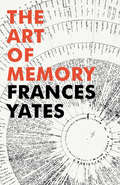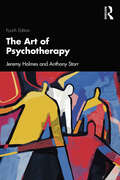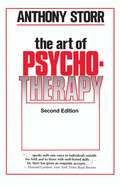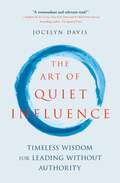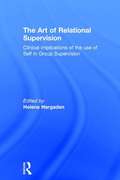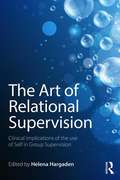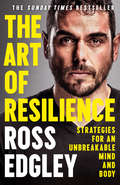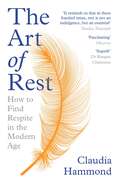- Table View
- List View
The Art of Memory
by Frances A YatesThis unique and brilliant book is a history of human knowledge. Before the invention of printing, a trained memory was of vital importance. Based on a technique of impressing 'places' and 'images' on the mind, the ancient Greeks created an elaborate memory system which in turn was inherited by the Romans and passed into the European tradition, to be revived, in occult form, during the Renaissance. Frances Yates sheds light on Dante’s Divine Comedy, the form of the Shakespearian theatre and the history of ancient architecture; The Art of Memory is an invaluable contribution to aesthetics and psychology, and to the history of philosophy, of science and of literature.
The Art of Modelling the Learning Process: Uniting Educational Research and Practice (Springer Texts in Education)
by Jimmie LeppinkBy uniting key concepts and methods from education, psychology, statistics, econometrics, medicine, language, and forensic science, this textbook provides an interdisciplinary methodological approach to study human learning processes longitudinally. This longitudinal approach can help to acquire a better understanding of learning processes, can inform both future learning and the revision of educational content and formats, and may help to foster self-regulated learning skills. The initial section of this textbook focuses on different types of research questions as well as practice-driven questions that may refer to groups or to individual learners. This is followed by a discussion of different types of outcome variables in educational research and practice, such as pass/fail and other dichotomies, multi-category nominal choices, ordered performance categories, and different types of quantifiable (i.e., interval or ratio level of measurement) variables. For each of these types of outcome variables, single-measurement and repeated-measurements scenarios are offered with clear examples. The book then introduces cross-sectional and longitudinal interdependence of learning-related variables through emerging network-analytic methods and in the final part the learned concepts are applied to different types of studies involving time series. The book concludes with some general guidelines to give direction to future (united) educational research and practice. This textbook is a must-have for all applied researchers, teachers and practitioners interested in (the teaching of) human learning, instructional design, assessment, life-long learning or applications of concepts and methods commonly encountered in fields such as econometrics, psychology, and sociology to educational research and practice.
The Art of Narrative Psychiatry: Stories of Strength and Meaning
by SuEllen HamkinsNarrative psychiatry empowers patients to shape their lives through story. Rather than focusing only on finding the source of the problem, in this collaborative clinical approach psychiatrists also help patients diagnose and develop their sources of strength. By encouraging the patient to explore their personal narrative through questioning and story-telling, the clinician helps the patient participate in and discover the ways in which they construct meaning, how they view themselves, what their values are, and who it is exactly that they want to be. These revelations in turn inform clinical decision-making about what it is that ails them, how they'd like to treat it, and what recovery might look like. The Art of Narrative Psychiatry is the first comprehensive description of narrative psychiatry in action. Engaging and accessible, it demonstrates how to help patients cultivate their personal sources of strength and meaning as resources for recovery. Illustrated with vivid case reports and in-depth accounts of therapeutic conversations, the book offers psychiatrists and psychotherapists detailed guidance in the theory and practice of this collaborative approach. Drawing inspiration from narrative therapy, post-modern philosophy, humanistic medicine, and social justice movements - and replete with ways to more fully manifest the intentions of the mental health recovery model - this engaging new book shows how to draw on the standard psychiatric toolbox while also maintaining focus on the patient's vision of the world and illuminating their skills and strengths. Written by a pioneer in the field, The Art of Narrative Psychiatry describes a breadth of nuanced, powerful narrative practices, including externalizing problems, listening for what is absent but implicit, facilitating re-authoring conversations, fostering communities of support, and creating therapeutic documents. The Art of Narrative Psychiatry addresses mental health challenges that range from mild to severe, including anxiety, depression, despair, anorexia/bulimia, perfectionism, OCD, trauma, psychosis, and loss. True to form, the author narrates her own experience throughout, sharing her internal thoughts and decision-making processes as she listens to patients. The Art of Narrative Psychiatry is necessary reading for any professional seeking to empower their patients and become a better, more compassionate clinician.
The Art of Narrative Psychiatry: Stories of Strength and Meaning
by SuEllen HamkinsNarrative psychiatry empowers patients to shape their lives through story. Rather than focusing only on finding the source of the problem, in this collaborative clinical approach psychiatrists also help patients diagnose and develop their sources of strength. By encouraging the patient to explore their personal narrative through questioning and story-telling, the clinician helps the patient participate in and discover the ways in which they construct meaning, how they view themselves, what their values are, and who it is exactly that they want to be. These revelations in turn inform clinical decision-making about what it is that ails them, how they'd like to treat it, and what recovery might look like. The Art of Narrative Psychiatry is the first comprehensive description of narrative psychiatry in action. Engaging and accessible, it demonstrates how to help patients cultivate their personal sources of strength and meaning as resources for recovery. Illustrated with vivid case reports and in-depth accounts of therapeutic conversations, the book offers psychiatrists and psychotherapists detailed guidance in the theory and practice of this collaborative approach. Drawing inspiration from narrative therapy, post-modern philosophy, humanistic medicine, and social justice movements - and replete with ways to more fully manifest the intentions of the mental health recovery model - this engaging new book shows how to draw on the standard psychiatric toolbox while also maintaining focus on the patient's vision of the world and illuminating their skills and strengths. Written by a pioneer in the field, The Art of Narrative Psychiatry describes a breadth of nuanced, powerful narrative practices, including externalizing problems, listening for what is absent but implicit, facilitating re-authoring conversations, fostering communities of support, and creating therapeutic documents. The Art of Narrative Psychiatry addresses mental health challenges that range from mild to severe, including anxiety, depression, despair, anorexia/bulimia, perfectionism, OCD, trauma, psychosis, and loss. True to form, the author narrates her own experience throughout, sharing her internal thoughts and decision-making processes as she listens to patients. The Art of Narrative Psychiatry is necessary reading for any professional seeking to empower their patients and become a better, more compassionate clinician.
The Art of Personality in Literature and Psychoanalysis
by Meg Harris WilliamsThe Art of Personality is a diverse selection of talks and papers on psychoanalysis and literature given by the author over the past ten years. They elaborate on the goal expressed by Milton as 'becoming a true poem': that is, seeing parallels between the gradual construction of the personality and the construction of a work of art, following an internal evolution on the lines of Bion's description of an 'endoskeletonous personality'. The works discussed range from classic Greek drama to Dostoevsky, Kafka, and Patrick White. The author's thoughts on our interaction with literature stand alongside those of Adrian Stokes and Richard Wollheim on understanding paintings. She brings together a broad knowledge of ancient and modern writings with a deep understanding of the creatively imaginative mind, illuminated by post-Kleinian psychoanalysis. This book will be a source of pleasure and inspiration both to general lovers of literature and to psychoanalytic workers who value the poetic aspects of their patients and their own forms of expression.'
The Art of Personality in Literature and Psychoanalysis
by Meg Harris WilliamsThe Art of Personality is a diverse selection of talks and papers on psychoanalysis and literature given by the author over the past ten years. They elaborate on the goal expressed by Milton as 'becoming a true poem': that is, seeing parallels between the gradual construction of the personality and the construction of a work of art, following an internal evolution on the lines of Bion's description of an 'endoskeletonous personality'. The works discussed range from classic Greek drama to Dostoevsky, Kafka, and Patrick White. The author's thoughts on our interaction with literature stand alongside those of Adrian Stokes and Richard Wollheim on understanding paintings. She brings together a broad knowledge of ancient and modern writings with a deep understanding of the creatively imaginative mind, illuminated by post-Kleinian psychoanalysis. This book will be a source of pleasure and inspiration both to general lovers of literature and to psychoanalytic workers who value the poetic aspects of their patients and their own forms of expression.'
The Art of Problem Posing
by Stephen I. Brown Marion I. WalterThe new edition of this classic book describes and provides a myriad of examples of the relationships between problem posing and problem solving, and explores the educational potential of integrating these two activities in classrooms at all levels. The Art of Problem Posing, Third Edition encourages readers to shift their thinking about problem posing (such as where problems come from, what to do with them, and the like) from the "other" to themselves and offers a broader conception of what can be done with problems. Special features include: an exploration of the logical relationship between problem posing and problem solving; sketches, drawings, and diagrams that illustrate the schemes proposed; and a special section on writing in mathematics.In the updated third edition, the authors specifically:*address the role of problem posing in the NCTM Standards;*elaborate on the concept of student as author and critic;*include discussion of computer applications to illustrate the potential of technology to enhance problem posing in the classroom;*expand the section on diversity/multiculturalism; and*broaden discussion of writing as a classroom enterprise.This book offers present and future teachers at the middle school, secondary school, and higher education levels ideas to enrich their teaching and suggestions for how to incorporate problem posing into a standard mathematics curriculum.
The Art of Problem Posing
by Stephen I. Brown Marion I. WalterThe new edition of this classic book describes and provides a myriad of examples of the relationships between problem posing and problem solving, and explores the educational potential of integrating these two activities in classrooms at all levels. The Art of Problem Posing, Third Edition encourages readers to shift their thinking about problem posing (such as where problems come from, what to do with them, and the like) from the "other" to themselves and offers a broader conception of what can be done with problems. Special features include: an exploration of the logical relationship between problem posing and problem solving; sketches, drawings, and diagrams that illustrate the schemes proposed; and a special section on writing in mathematics.In the updated third edition, the authors specifically:*address the role of problem posing in the NCTM Standards;*elaborate on the concept of student as author and critic;*include discussion of computer applications to illustrate the potential of technology to enhance problem posing in the classroom;*expand the section on diversity/multiculturalism; and*broaden discussion of writing as a classroom enterprise.This book offers present and future teachers at the middle school, secondary school, and higher education levels ideas to enrich their teaching and suggestions for how to incorporate problem posing into a standard mathematics curriculum.
The Art of Procrastination: A Guide to Effective Dawdling, Lollygagging and Postponing
by John PerryAt last: Self-help for procrastinators. (The secret: acceptance!) Filled with charm, tongue-in-cheek wit, and the insights of a lifelong introspective dawdler, The Art of Procrastination is a philosophical self-help program for every reader who suffers the pangs of being a procrastinator. John Perry celebrates this nearly universal character flaw by pointing out how often procrastinators are, paradoxically, doers. They may not be accomplishing everything on their to-do lists, but that doesn&’t make them slackers. It just indicates a need to rethink the to-do list. He also introduces the philosophical notion of akrasia (the mystery of why we often choose to act against our better judgement), examines the torturous relationship between procrastination and perfectionism, and shows how to give yourself permission to do an imperfect but, in fact, perfectly good job. These are strategies—task triage, horizontal organization. Underlying causes—right-parenthesis deficit disorder. Anecdotes and ideas. But above all, an attitude of acceptance. Pat yourself on the back for what you manage to get done—but don&’t stop enjoying that time you waste, too. Who knows where daydreams will lead?
The Art of Professional Communication: Strategies that Advance Careers
by Daniel PlungGoing beyond the mechanics of professional communication, this book combines insights into the overlooked implicit demands of corporate communication challenges with the proven strategies and techniques that distinguish professionals as capable communicators and candidates for promotion.The practical strategies offered in this book represent professional communication principles filtered through the lens of the author’s 40-year career, that enabled him to rise from an initial assignment as a technical editor to positions of senior management directing large, diverse business and technical organizations. Here, he has collected into one resource the reasoned and disciplined decision-making processes, tools, and techniques essential to craft communications, precisely attuned to the explicit and implicit expectations of each assignment and supported by a structure and presentation logic that delivers a totally responsive and accurately targeted product. This is an essential guide for all levels of professionals who recognize the need to distinguish themselves within a highly competitive career environment.Business professionals and instructors in corporate training programs, supervisors and managers, and students in professional communication programs will welcome this deep dive into the real-world challenges and opportunities in professional communication and the role effective communication plays in career advancement.
The Art of Professional Communication: Strategies that Advance Careers
by Daniel PlungGoing beyond the mechanics of professional communication, this book combines insights into the overlooked implicit demands of corporate communication challenges with the proven strategies and techniques that distinguish professionals as capable communicators and candidates for promotion.The practical strategies offered in this book represent professional communication principles filtered through the lens of the author’s 40-year career, that enabled him to rise from an initial assignment as a technical editor to positions of senior management directing large, diverse business and technical organizations. Here, he has collected into one resource the reasoned and disciplined decision-making processes, tools, and techniques essential to craft communications, precisely attuned to the explicit and implicit expectations of each assignment and supported by a structure and presentation logic that delivers a totally responsive and accurately targeted product. This is an essential guide for all levels of professionals who recognize the need to distinguish themselves within a highly competitive career environment.Business professionals and instructors in corporate training programs, supervisors and managers, and students in professional communication programs will welcome this deep dive into the real-world challenges and opportunities in professional communication and the role effective communication plays in career advancement.
The Art of Psychotherapy
by Jeremy Holmes Anthony StorrStorr’s The Art of Psychotherapy first appeared in 1979 and became an instant classic. After Storr’s death, a third edition was rewritten and revised by Jeremy Holmes, and this fourth edition is a further up-to-date iteration. Storr (1920–2001) and Holmes, both medical psychoanalytic psychotherapists, are ‘elders’ in the world of psychotherapy. Their eclectic, experienced and cultured voices offer students and psychotherapy practitioners clinical wisdom hard to find elsewhere. Their book expounds in a very practical way the issues entailed in setting up and maintaining a psychotherapeutic relationship and practice: how to introduce oneself, arrange one’s consulting room, establish a contract, when and how to make ‘interpretations'. The second half of the book deals with more general and often problematic issues, including how to align therapy in the light of diagnosis, working with ‘difficult’ patients, therapy termination, and the life course of a therapist, ending with a valedictory overview. In this fourth edition, Holmes has added a chapter on the scientific validation of psychotherapy, sections on tele- and e-therapy, non-binary gender and sexual identities and the impact of race and class on the therapeutic relationship. This engaging, accessible and profound book is essential reading for psychotherapists, counsellors, psychiatrists and mental health practitioners in training or practice.
The Art of Psychotherapy
by Jeremy Holmes Anthony StorrStorr’s The Art of Psychotherapy first appeared in 1979 and became an instant classic. After Storr’s death, a third edition was rewritten and revised by Jeremy Holmes, and this fourth edition is a further up-to-date iteration. Storr (1920–2001) and Holmes, both medical psychoanalytic psychotherapists, are ‘elders’ in the world of psychotherapy. Their eclectic, experienced and cultured voices offer students and psychotherapy practitioners clinical wisdom hard to find elsewhere. Their book expounds in a very practical way the issues entailed in setting up and maintaining a psychotherapeutic relationship and practice: how to introduce oneself, arrange one’s consulting room, establish a contract, when and how to make ‘interpretations'. The second half of the book deals with more general and often problematic issues, including how to align therapy in the light of diagnosis, working with ‘difficult’ patients, therapy termination, and the life course of a therapist, ending with a valedictory overview. In this fourth edition, Holmes has added a chapter on the scientific validation of psychotherapy, sections on tele- and e-therapy, non-binary gender and sexual identities and the impact of race and class on the therapeutic relationship. This engaging, accessible and profound book is essential reading for psychotherapists, counsellors, psychiatrists and mental health practitioners in training or practice.
The Art of Psychotherapy
by Anthony StorrAnthony Storr's accessible and humane account of the art of psychotherapy has been widely read by practitioners in training and others in the helping professions, as well as many general readers. The second edition includes a thoroughly revised account of the obsessional personality, and a new chapter that draws on the author's recent work on the importance of the processes of healing that take place within the isolated individual.
The Art of Psychotherapy
by Anthony StorrAnthony Storr's accessible and humane account of the art of psychotherapy has been widely read by practitioners in training and others in the helping professions, as well as many general readers. The second edition includes a thoroughly revised account of the obsessional personality, and a new chapter that draws on the author's recent work on the importance of the processes of healing that take place within the isolated individual.
The Art of Quiet Influence: Timeless Wisdom for Leading Without Authority
by Jocelyn DavisInfluence is getting things done without coercion. It's strength without force-mindfulness in action. Master influencers walk lightly, talk softly and have no need of a big stick, yet collective success hinges on their words and deeds.Anyone can be a quiet influencer. Featuring twelve specific practices, twelve typical pitfalls and dozens of powerful stories and examples, The Art of Quiet Influence is a roadmap for the journey. Author Jocelyn Davis weaves together the timeless wisdom of Eastern thinkers-from Confucius to the Buddha, from Rumi to Gandhi-with research and insights from modern-day experts, revealing what's wrong with the Western view of influence as short-term persuasion and showing instead how to create trust-based collaborations with lasting impact.
The Art Of Relational Supervision: Clinical Implications Of The Use Of Self In Group Supervision
by Helena HargadenThe Art of Relational Supervision demonstrates the clinical implications of the relational approach when applied to supervision. Describing her philosophical and theoretical rationale for setting up relational supervision groups, Helena Hargaden's goal in supervision is to reveal the relational unconscious within the client/therapist relationship. Here, with chapters from members of these groups, the vitality of supervision is brought to life as the clinical implications of the therapist's internal world are highlighted by group members. The complexity of group dynamics are explored and psychotherapists show how this positively affects their work with clients and patients. The main themes examined in the book are the: Bi-directionality of the relational unconscious Ubiquity of therapeutic enactments and ruptures Intuitive use of improvisation Co-creation of the intersubjective third - the analytic third Focus on mutuality and reciprocity Filled with case study examples, readers of The Art of Relational Supervisionwill gain a deep insight into the complex dynamics which form an integral part of any supervision and discover how, this type of relational approach strengthens the therapeutic relationship to bring about significant psychological change for the client. It will be an invaluable resource for psychotherapists, counsellors and psychologists. 9781138838451 9781138838468 9781315727882
The Art Of Relational Supervision: Clinical Implications Of The Use Of Self In Group Supervision (PDF)
by Helena HargadenThe Art of Relational Supervision demonstrates the clinical implications of the relational approach when applied to supervision. Describing her philosophical and theoretical rationale for setting up relational supervision groups, Helena Hargaden's goal in supervision is to reveal the relational unconscious within the client/therapist relationship. Here, with chapters from members of these groups, the vitality of supervision is brought to life as the clinical implications of the therapist's internal world are highlighted by group members. The complexity of group dynamics are explored and psychotherapists show how this positively affects their work with clients and patients. The main themes examined in the book are the: Bi-directionality of the relational unconscious Ubiquity of therapeutic enactments and ruptures Intuitive use of improvisation Co-creation of the intersubjective third - the analytic third Focus on mutuality and reciprocity Filled with case study examples, readers of The Art of Relational Supervisionwill gain a deep insight into the complex dynamics which form an integral part of any supervision and discover how, this type of relational approach strengthens the therapeutic relationship to bring about significant psychological change for the client. It will be an invaluable resource for psychotherapists, counsellors and psychologists. 9781138838451 9781138838468 9781315727882
The Art of Relational Supervision: Clinical Implications of the Use of Self in Group Supervision
by Helena HargadenThe Art of Relational Supervision demonstrates the clinical implications of the relational approach when applied to supervision. Describing her philosophical and theoretical rationale for setting up relational supervision groups, Helena Hargaden’s goal in supervision is to reveal the relational unconscious within the client/therapist relationship. Here, with chapters from members of these groups, the vitality of supervision is brought to life as the clinical implications of the therapist's internal world are highlighted by group members. The complexity of group dynamics are explored and psychotherapists show how this positively affects their work with clients and patients. The main themes examined in the book are the: Bi-directionality of the relational unconscious Ubiquity of therapeutic enactments and ruptures Intuitive use of improvisation Co-creation of the intersubjective third – the analytic third Focus on mutuality and reciprocity Filled with case study examples, readers of The Art of Relational Supervision will gain a deep insight into the complex dynamics which form an integral part of any supervision and discover how, this type of relational approach strengthens the therapeutic relationship to bring about significant psychological change for the client. It will be an invaluable resource for psychotherapists, counsellors and psychologists.
The Art of Relational Supervision: Clinical Implications of the Use of Self in Group Supervision (PDF)
by Helena HargadenThe Art of Relational Supervision demonstrates the clinical implications of the relational approach when applied to supervision. Describing her philosophical and theoretical rationale for setting up relational supervision groups, Helena Hargaden’s goal in supervision is to reveal the relational unconscious within the client/therapist relationship. Here, with chapters from members of these groups, the vitality of supervision is brought to life as the clinical implications of the therapist's internal world are highlighted by group members. The complexity of group dynamics are explored and psychotherapists show how this positively affects their work with clients and patients. The main themes examined in the book are the: Bi-directionality of the relational unconscious Ubiquity of therapeutic enactments and ruptures Intuitive use of improvisation Co-creation of the intersubjective third – the analytic third Focus on mutuality and reciprocity Filled with case study examples, readers of The Art of Relational Supervision will gain a deep insight into the complex dynamics which form an integral part of any supervision and discover how, this type of relational approach strengthens the therapeutic relationship to bring about significant psychological change for the client. It will be an invaluable resource for psychotherapists, counsellors and psychologists.
The Art of Relational Supervision: Clinical Implications of the Use of Self in Group Supervision
by Helena HargadenThe Art of Relational Supervision demonstrates the clinical implications of the relational approach when applied to supervision. Describing her philosophical and theoretical rationale for setting up relational supervision groups, Helena Hargaden’s goal in supervision is to reveal the relational unconscious within the client/therapist relationship. Here, with chapters from members of these groups, the vitality of supervision is brought to life as the clinical implications of the therapist's internal world are highlighted by group members. The complexity of group dynamics are explored and psychotherapists show how this positively affects their work with clients and patients. The main themes examined in the book are the: Bi-directionality of the relational unconscious Ubiquity of therapeutic enactments and ruptures Intuitive use of improvisation Co-creation of the intersubjective third – the analytic third Focus on mutuality and reciprocity Filled with case study examples, readers of The Art of Relational Supervision will gain a deep insight into the complex dynamics which form an integral part of any supervision and discover how, this type of relational approach strengthens the therapeutic relationship to bring about significant psychological change for the client. It will be an invaluable resource for psychotherapists, counsellors and psychologists.
The Art of Relational Supervision: Clinical Implications of the Use of Self in Group Supervision
by Helena HargadenThe Art of Relational Supervision demonstrates the clinical implications of the relational approach when applied to supervision. Describing her philosophical and theoretical rationale for setting up relational supervision groups, Helena Hargaden’s goal in supervision is to reveal the relational unconscious within the client/therapist relationship. Here, with chapters from members of these groups, the vitality of supervision is brought to life as the clinical implications of the therapist's internal world are highlighted by group members. The complexity of group dynamics are explored and psychotherapists show how this positively affects their work with clients and patients. The main themes examined in the book are the: Bi-directionality of the relational unconscious Ubiquity of therapeutic enactments and ruptures Intuitive use of improvisation Co-creation of the intersubjective third – the analytic third Focus on mutuality and reciprocity Filled with case study examples, readers of The Art of Relational Supervision will gain a deep insight into the complex dynamics which form an integral part of any supervision and discover how, this type of relational approach strengthens the therapeutic relationship to bring about significant psychological change for the client. It will be an invaluable resource for psychotherapists, counsellors and psychologists.
The Art of Resilience: Strategies For An Unbreakable Mind And Body
by Ross Edgley‘Incredible individual, incredible book, incredible story.’ CHRIS HEMSWORTH ‘A hero who is as humble as he is resilient… testament to a “never give up” spirit!’ BEAR GRYLLS ‘From reading this book, the message that comes shining through is this: you can achieve anything.’ ANT MIDDLETON
The Art of Rest: How to Find Respite in the Modern Age
by Claudia HammondShortlisted for the British Psychological Society Book Award for Popular Science Much of value has been written about sleep, but rest is different; it is how we unwind, calm our minds and recharge our bodies. The Art of Rest draws on ground-breaking research Claudia Hammond collaborated on: ‘The Rest Test’, the largest global survey into rest ever undertaken, completed by 18,000 people across 135 different countries. The survey revealed how people get rest and how it is directly linked to your sense of wellbeing. Counting down through the top ten activities which people find most restful, Hammond explains why rest matters, examines the science behind the results to establish what really works and offers a roadmap for a new, more restful and balanced life.
